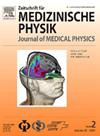Reducing electromagnetic interference in MR thermometry: A comparison of setup configurations for MR-guided microwave ablations
IF 2.4
4区 医学
Q2 RADIOLOGY, NUCLEAR MEDICINE & MEDICAL IMAGING
引用次数: 0
Abstract
Magnetic Resonance (MR) thermometry is used for the monitoring of MR-guided microwave ablations (MWA), and for the intraoperative evaluation of ablation regions. Nevertheless, the accuracy of temperature mapping may be compromised by electromagnetic interference emanating from the microwave (MW) generator. This study evaluated different setups for improving magnetic resonance imaging (MRI) during MWA with a modified MW generator.
MWA was performed in 15 gel phantoms comparing three setups: The MW generator was placed outside the MR scanner room, either connected to the MW applicator using a penetration panel with a radiofrequency (RF) filter and a 7 m coaxial cable (Setup 1), or through a waveguide using a 5 m coaxial cable (Setup 2). Setup 3 employed the MW generator within the MR scan room, connected by a 5 m coaxial cable. The coaxial cables in setups 2 and 3 were modified with custom shielding to reduce interference. The setups during ablation (active setup) were compared to a reference setup without the presence of the MW system. Thermometry and thermal dose maps (CEM43 model) were compared for the three configurations. Primary endpoints for assessment were signal-to-noise ratio (SNR), temperature precision, Sørensen-Dice-Coefficient (DSC), and RF-noise spectra.
Setup 3 showed highly significant electromagnetic interference during ablation with a SNR decrease by −60.4%±13.5% () compared to reference imaging. For setup 1 and setup 2 no significant decrease in SNR was measured with differences of −2.9%±9.8% () and −1.5%±12.8% (), respectively. SNR differences were significant between active setups 1 and 3 with −51.2%±16.1% () and between active setups 2 and 3 with −59.0%±15.5% () but not significant between active setups 1 and 2 with 19.0%±13.7% (). Furthermore, no significant differences were seen in temperature precision or DSCs between all setups, ranging from 0.33 °C ± 0.04 °C (Setup 1) to 0.38 °C ± 0.06 °C (Setup 3) () and from 87.0%±1.6% (Setup 3) to 88.1%±1.6% (Setup 2) (), respectively.
Both setups (1 and 2) with the MW generator outside the MR scanner room were beneficial to reduce electromagnetic interference during MWA. Moreover, provided that a shielded cable is utilized in setups 2 and 3, all configurations displayed negligible differences in temperature precision and DSCs, indicating that the location of the MW generator does not significantly impact the accuracy of thermometry during MWA.
减少磁共振测温中的电磁干扰:核磁共振引导下微波消融的设置配置比较。
磁共振(MR)测温技术用于监测磁共振引导下的微波消融术(MWA),以及术中对消融区域进行评估。然而,微波(MW)发生器产生的电磁干扰可能会影响温度测绘的准确性。本研究评估了在使用改进型微波发生器进行 MWA 期间改进磁共振成像(MRI)的不同设置。在 15 个凝胶模型中进行了 MWA,对三种设置进行了比较:磁共振波发生器放置在磁共振扫描室外,使用带有射频(RF)滤波器和 7 米同轴电缆的穿透板连接到磁共振波应用器(设置 1),或使用 5 米同轴电缆通过波导管连接(设置 2)。设置 3 使用磁共振扫描室内的 MW 发生器,通过 5 米长的同轴电缆连接。设置 2 和设置 3 中的同轴电缆经过定制屏蔽处理,以减少干扰。将消融过程中的设置(主动设置)与不使用 MW 系统的参考设置进行了比较。对三种配置的热测量和热剂量图(CEM43 模型)进行了比较。评估的主要终点是信噪比 (SNR)、温度精度、索伦森-迪斯系数 (DSC) 和射频噪声频谱。设置 3 在消融过程中显示出非常明显的电磁干扰,信噪比降低了 -60.4%±13.5% (p
本文章由计算机程序翻译,如有差异,请以英文原文为准。
求助全文
约1分钟内获得全文
求助全文
来源期刊
CiteScore
3.70
自引率
10.00%
发文量
69
审稿时长
65 days
期刊介绍:
Zeitschrift fur Medizinische Physik (Journal of Medical Physics) is an official organ of the German and Austrian Society of Medical Physic and the Swiss Society of Radiobiology and Medical Physics.The Journal is a platform for basic research and practical applications of physical procedures in medical diagnostics and therapy. The articles are reviewed following international standards of peer reviewing.
Focuses of the articles are:
-Biophysical methods in radiation therapy and nuclear medicine
-Dosimetry and radiation protection
-Radiological diagnostics and quality assurance
-Modern imaging techniques, such as computed tomography, magnetic resonance imaging, positron emission tomography
-Ultrasonography diagnostics, application of laser and UV rays
-Electronic processing of biosignals
-Artificial intelligence and machine learning in medical physics
In the Journal, the latest scientific insights find their expression in the form of original articles, reviews, technical communications, and information for the clinical practice.

 求助内容:
求助内容: 应助结果提醒方式:
应助结果提醒方式:


